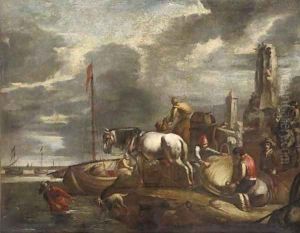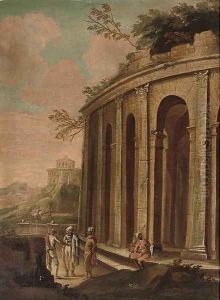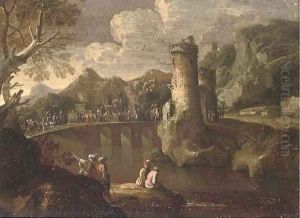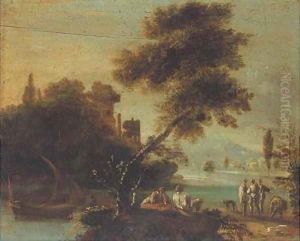Giovanni De Momper Paintings
Giovanni de Momper, also known as Joos de Momper the Younger, was a prominent landscape painter of the Flemish Baroque period. Born in 1564 in Antwerp, he hailed from a family of artists; his father, Bartholomeus de Momper, and grandfather were both painters. De Momper's work is often characterized by its innovative approach to landscape painting, which was a significant departure from the Mannerist style prevalent during his time.
De Momper's landscapes typically feature a panoramic view, with a high horizon and dramatic, rocky mountains, which may have been influenced by the Alpine scenery he encountered during his travels. His paintings often depict a world in transition between the real and the imaginary, mixing detailed foregrounds with more fantastical and exaggerated mountainous backgrounds. This juxtaposition of the realistic and the idealized was a hallmark of his style, and it contributed to the development of the landscape genre in the 17th century.
In his early career, de Momper was influenced by the work of Pieter Bruegel the Elder, another famed Flemish artist known for his landscapes and peasant scenes. However, de Momper's style evolved to become more distinct, with a bolder use of color and a less structured approach to composition. He was among the first to introduce a more monumental scale to landscape painting, which allowed for a more immersive experience for the viewer.
De Momper also collaborated with other artists, such as Jan Brueghel the Elder and Frans Francken the Younger, who would paint the staffage (people and animals) within de Momper's landscapes. This was a common practice at the time, as specialized artists would often work together to capitalize on their respective strengths.
Despite his success and influence, de Momper did not achieve the lasting fame of some of his contemporaries. His works were somewhat overshadowed by the later achievements of artists like Rubens and van Dyck. Nevertheless, he was a prolific artist, and his works were collected by art connoisseurs across Europe during his lifetime.
De Momper died in 1635 in Antwerp. Today, his works can be found in major art museums around the world, including the Prado Museum in Madrid, the Louvre in Paris, and the Kunsthistorisches Museum in Vienna. His contributions to the development of landscape painting have been recognized by art historians, and he is considered an important figure in the transition from the 16th-century Mannerist style to the more naturalistic Baroque landscape painting.



